I pivoted and I didn’t tell you 8 Nov 2020 2:07 PM (4 years ago)
Hey there! It’s been a while.
As you can tell from the title, I paused working on 20 Seconds some weeks ago. Now, in autumn, the Corona numbers prove me right; the exhibition and event industry will struggle to make it through a winter without in-person conferences. Online events are much less visited and not really accepted yet, from what I can tell. We’re all spending too much time on video calls already, and we’re still hoping to get back to normal soon.
The decision wasn’t an easy one. I didn’t see much sense in continuing with the sudden loss of a market, but I also felt uncomfortable to pause something I had just announced. This project was ought to become a success, not another pipe crap! But there was no point in continuing unmotivated. I kept looking for other opportunities.
In the meantime, the ordinary and supposedly unrelated family-life continued, unimpressed by my struggle.
A supposedly unrelated family-life story
My wife, Sarah, is an avid runner. While I was mulling over 20 Seconds, I followed her training.
She was suffering from an injury throughout the most of 2019. During injuries and as an alternative sport, spinning seems to be popular among runners. A US company, Peloton, was supposed to launch their bike in Germany soon and appeared on our radar. I felt that the total investment would be a little too much for a spinning bike, but I was convinced that it would end up in many single-family houses of the upper class. So I bought Peloton stock in September 2019. I reconsidered the investment in December 2019 when the company was mocked due to a sexist ad. Luckily, I decided to hold on to it, not knowing that a pandemic would force gyms to close soon. 2020, the stock price kept rising, slowly, but continuously.
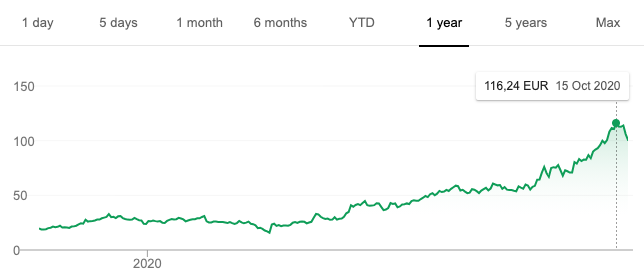
In the middle of 2020 there was still hope that the larger running events could take place. Sarah had successfully recovered and was hoping to finish her first Marathon in October. When she returned from her training runs, I regularly overheard her complaining that everyone must have started running after gyms were closed due to Coronavirus.
Sarah and I also kept talking about how we could improve our other project, Abnehmen mit Sarah (Weightloss with Sarah). Frequent questions we were getting there were: How did you start running? How should I start running if I am overweight? We were contemplating to offer running exercise plans tailored towards overweight people as an extra paid module on the platform, and we thought about asking her trainer for support in putting them together.
To summarize, individual exercise is a trend accelerated by the pandemic, noticable both on the stock markets and on the streets, and right now I would rather invest time and money into that than into huge in-person events.
What gives?
We kept thinking about the idea to offer running exercise plans, and we worked out how this could work inside of our existing platform. The more we thought about the idea, the more we saw potential for an entirely new product.
The other day, I was accompanying Sarah to a spiroergometry test at her trainer’s place. While driving, I had a flash of inspiration and said: let’s not just offer individualized training plans to runners; let’s offer this to other trainers or gyms, too, so that they could share plans with their clients; it could bring added value to their offering, and it could be a great medium for those who are still sharing plans as Excel sheets.
We asked Sarahs trainer, Oliver, for support on that day, and he agreed. One thing came to another, several late evening calls followed where we narrowed down our product vision, and in parallel I started building an entirely new product. Oliver became part of the team and we agreed to start a dedicated company.
So, I have pivoted, and now I have told you.
Status Quo
On the technical side, a huge part of the mobile app is already done. I could reuse plenty of stuff I created for 20 Seconds, and I learned a lot while building that, so the app development went relatively smooth. The app communicates with a backend which keeps track of the available plans and exercises and each runner’s progress. There’s also an admin UI where we can administer the system and setup new plans or exercises. The actual plan structure is still read from Google Sheets because Oliver started creating with Excel. It’s lean, and it works nicely.
The company is in the process of being registered. We contemplated whether a simple partnership would be enough, but we found a dedicated legal entity to be a better choice. In Germany, starting a limited liability company (GmbH) also means a certain investment for share capital, so it also underlines that all partners are serious about the endeavor.
The branding is already mostly done and we’ll go live with our landing page any time soon. For the time being, we’ll start with our local, German speaking market, but everything is prepared for localization if need be.
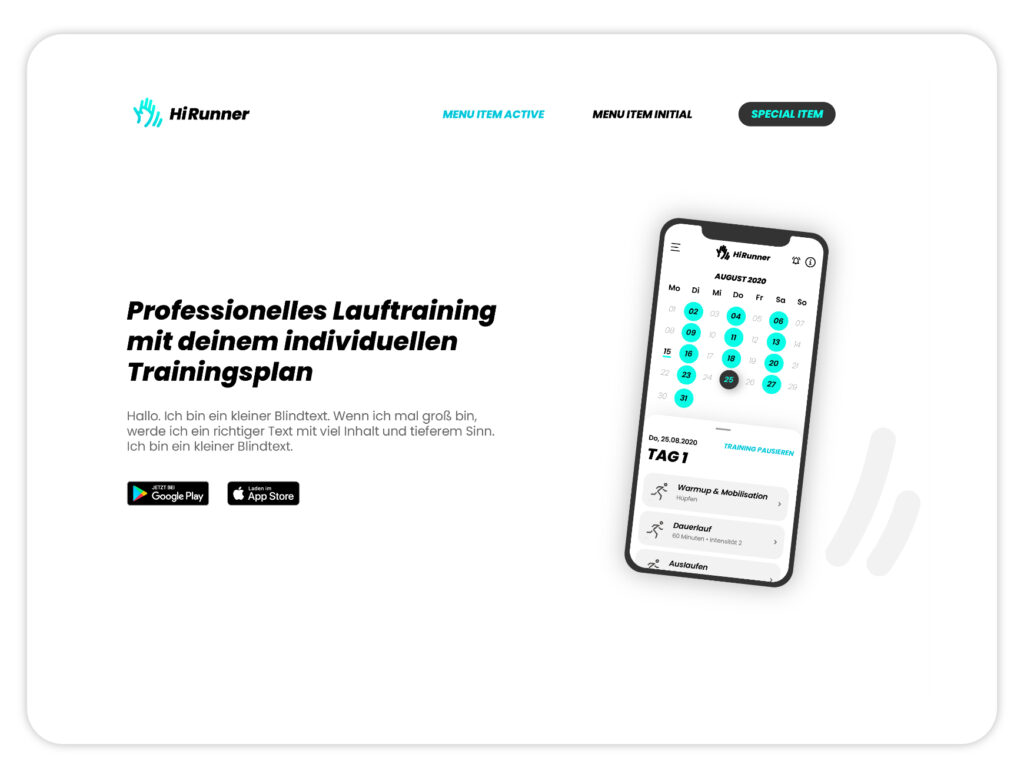
Personally, I am relieved that some other opportunity came up while I was struggling to move forward with 20 Seconds. And while I like working alone and on my own terms in my spare time, I also enjoy working with other people and I think it’s only beneficial if we can split our efforts into our areas of expertise.
N.B. You can probably tell that my wife is a great inspiration to me and to others; she’s awesome. Go follow her on her Instagram.
Photo by Ian Schneider on Unsplash.
Hey! You are not alone. 27 Jun 2020 3:13 PM (4 years ago)
Many things kept me busy the last weeks. Today, I write about another, already running side project.
You may have heard about the hey.com controversy in the last few weeks. Long story short, hey.com built an app for a subscription product, didn’t want to let users pay through In App Purchases and lose up to 30% to Apple, got their initial release approved and a subsequent bugfix update rejected for violation of the App Store guidelines. 37signals, the makers of Hey, used their social media and press outreach for a huge and effective outcry right before WWDC and eventually caused Apple to make some improvements to the App Store guidelines and also offer a way forward to get their app re-approved with some changes.
Before I move on, I’ll show you something I was working on. Very proudly, I must say.
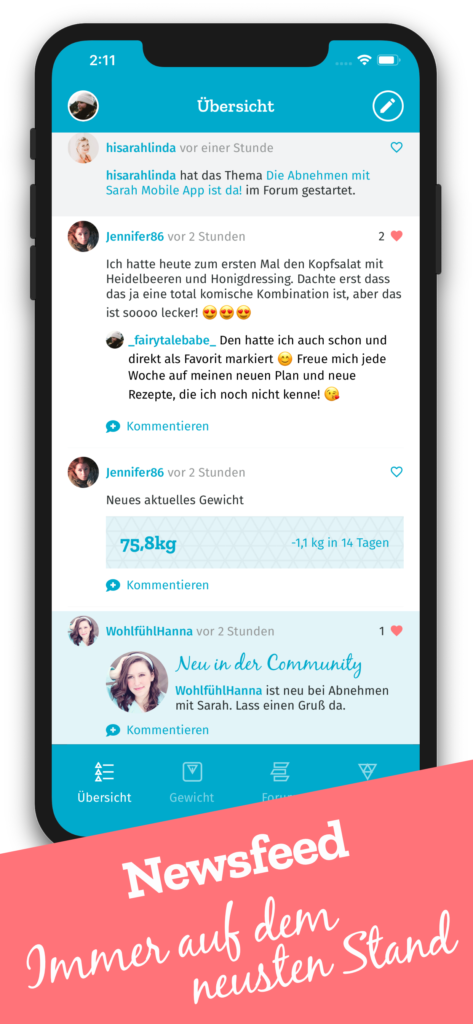
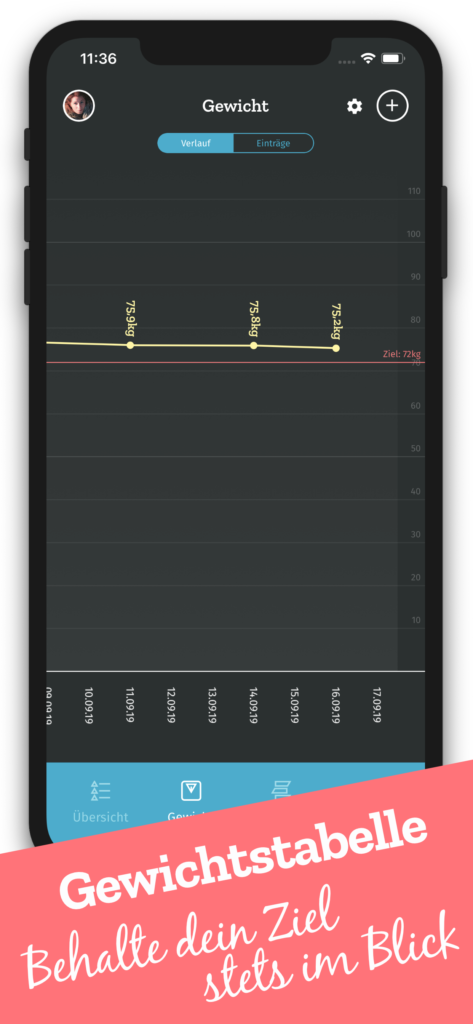
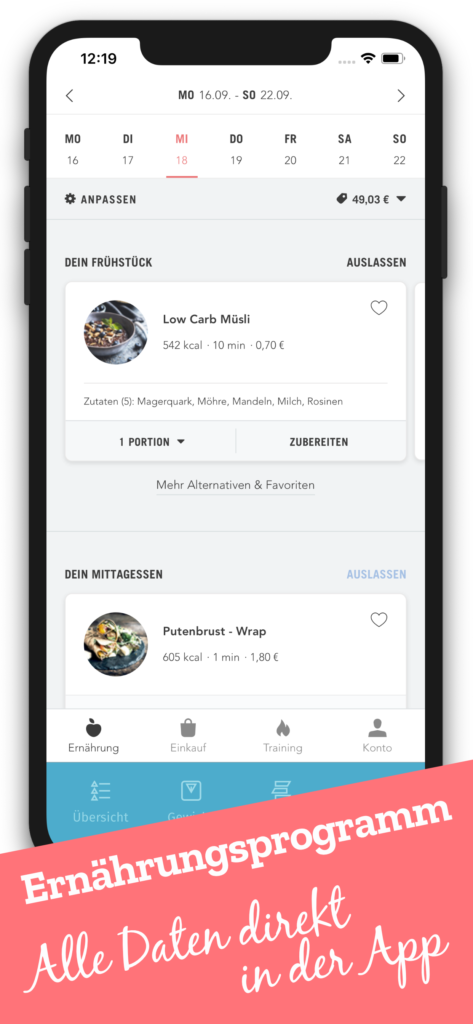
These are some of the App Store images that I had prepared. Ignore the fact that the texts are German, it’s not relevant for my point.
The app hasn’t made it into the store, yet.
I am not going into any detail but I think it’s enough to say that I know Hey’s problem very well, since October 2019 already.
The problematic part is the screenshot at the very right. It shows a personalized nutrition plan and it’s a webview, displaying content from a 3rd party. But in order to get there, one needs to login in the webview first. The rest of the app is functional, only this screen requires a separate login. The app combines a community and some free tools with this franchised, paid feature. It exists as a web version since 2018 and it’s one side business operated by the company I started together with my wife to combine all our families’ efforts. (I’ll write about that some time later.)
But since it’s a franchise, users won’t buy from our entity. The users conclude the purchase contract for the nutrition program with the franchisor, and it’s outside of my control. While Hey.com could decide to offer In App Purchases (and maybe increase their in-app-purchase prices to make up for the lost commission), I don’t even have this choice. Hey.com were allowed to publish an update if they offered an option for their users to test the service for free. I don’t have this choice either.
Even though this is one of the most requested features by our community – a mobile app which combines all the things -, and even though it’s built and ready to be published, I can’t offer it.
It’s a frustrating situation to be in.
But it doesn’t end here. Someone in Apples press or developer relations department really screwed up with the message below.
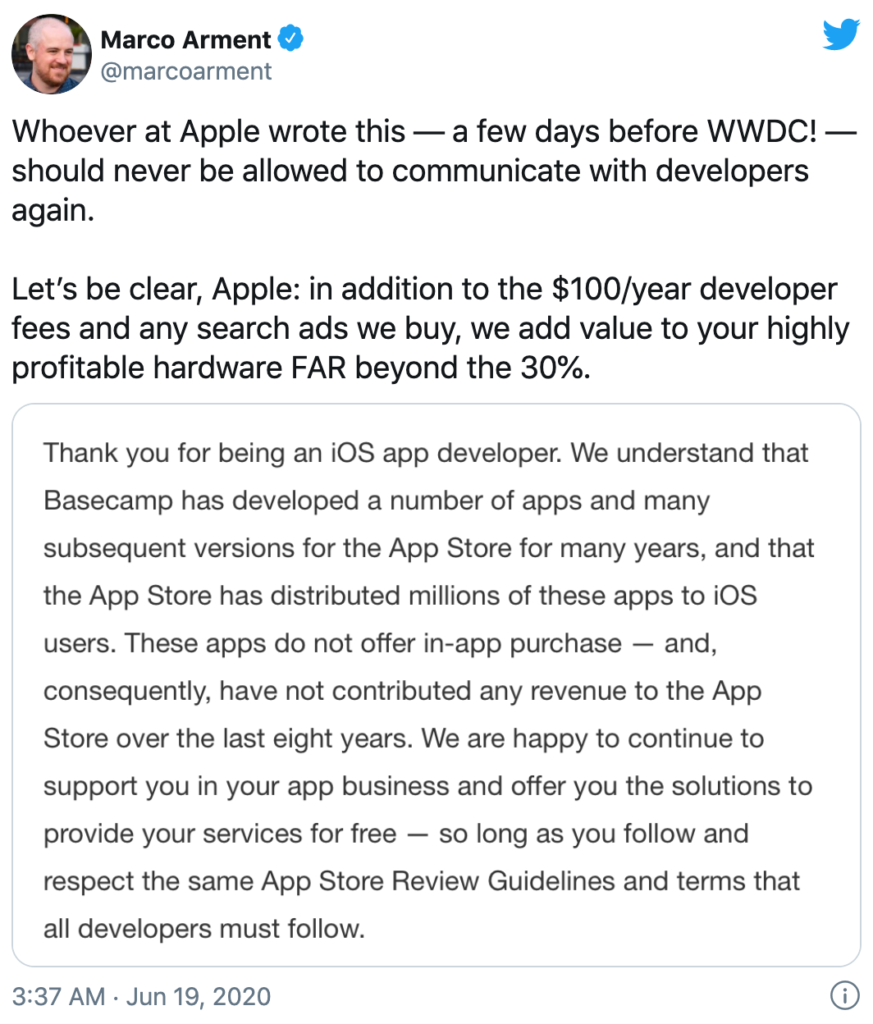
I still get nausea when I read this and I feel disgusted and incredibly helpless over a message like that. Developers who don’t generate any direct revenue for Apple with their app (but pay a $99 fee per year, just saying) should be happy to be allowed on the App Store at all – that’s how I read this statement. They don’t seem to consider that any app which provides value to their users increases the value and attractiveness of the entire ecosystem.
I am writing all this because I needed some time away from 20 Seconds, and I decided to revive the mobile app above that didn’t survive the October 2019 review. I had learned so many new things while working on the 20 Seconds mobile app and I also had to upgrade several packages that I nearly touched every source file in the end.
The tab with the 3rd party nutrition plan webview didn’t survive my refactoring. Because I have no large following, no connections to Apple execs, and not the means to challenge another rejection. I am a solo developer scared of sanctions because I mentioned my app’s rejection publically or calling out Apple. I’ll have to deal with disappointed users instead, and the bad ratings that are coming with it. I am scared of uploading the next binary. That’s the sad state of developer relations today.
But hey! I know I am not alone, and I hope that if not 37signals and not Apple, maybe the EU Antitrust investigation of the App Store rules will lead to a change.
Photo by Markus Spiske on Unsplash
BotPreview.com is now closed 9 May 2020 10:40 AM (4 years ago)
When you’re hitting this post, you likely tried to visit BotPreview, my tool to create previews of Messenger chatbot interactions.
After more than three years, I decided to pull the plug and shut it down. If you have been using BotPreview in the past, I thank you for being a user and hope you found it to be useful!
Keep reading if you’re interested in why I pulled the plug.
More than three years ago, I launched BotPreview, a web application to create HTML, GIF or MP4 video previews of chatbot interactions.
When Mark Zuckerberg announced the launch of the Facebook Messenger Platform at F8 2016, I thought it was a pretty big deal.
I am fascinated by the paradigm shift that chatbots introduce. While we worked hard towards a responsive, mobile-first, retina-ready, cutting-edge user experience, chatbots reduce UI/UX to one of the very basic means of user interface: text input and text output.
I, in 2017
I was expecting a second “app store hype”, a wave of bots and micro-apps for Messenger. I wanted to be part of that hype.
I tried to learn as much as I could about the Messenger Platform. First, I wrote a pre-order bot where restraurants could maintain their menus and users could pre-order meals and get notified once they’re ready for pick up. Then I wrote a simple Amazon price drop notification bot. People could add Amazon products to their wishlists and the bot would notify them when the price drops. Then, with PSD2 on the horizon, I thought I could build a bot for bank account access. I wanted to have a simple landing page with a demo on it. I recognized that there was nothing available to produce good looking mocks of chatbot interactions. So I built a jQuery plugin to quickly script a faked Messenger dialogue rendered in the browser. And then I thought, why not build a nice editor around it?
That’s how BotPreview was born. As an editor-wrapper around my jQuery plugin.
Turns out, my hypothesis was flawed. I was catering for only one side of the market, the marketers, designers or product managers building chatbots. And this market was still a relatively small one. I also made a couple of mistakes on the way, like only allowing Facebook Connect for login in the beginning, for a tool which was used mostly for work; or never doing any paid advertising; or never leaving beta and never charging for the tool although I had prepared everything. Over time, BotPreview users grew slowly.
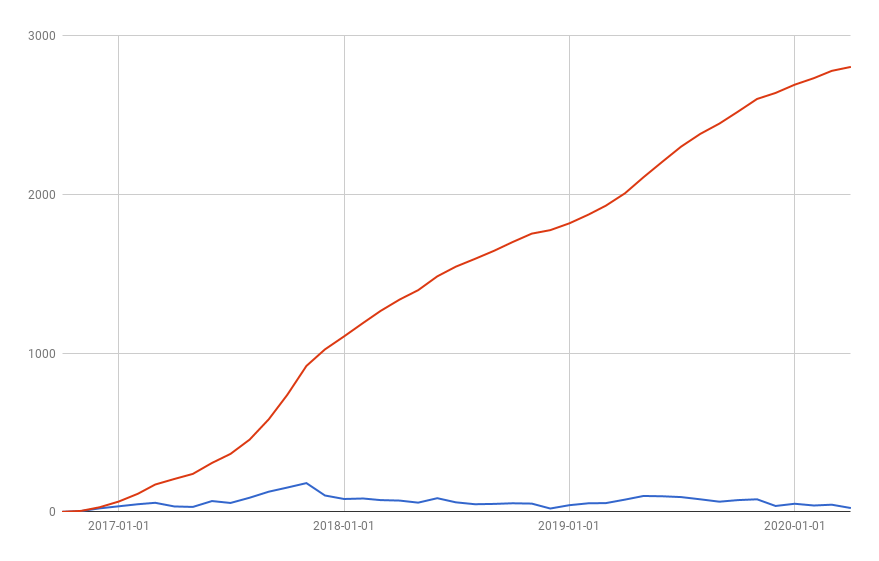
As of today, 2803 users have created 5430 projects (bot designs) and 5521 exports which amounts to a total of 12 GB of uploaded and generated assets.
This year, Facebook removed bots from public view in the latest Messenger app releases in favor of size and performance. Reportedly there are currently 300.000 bots on the Messenger Platform, which I find to be quite a small number for a platform with ~2 billion users.
On April 30th, I will shut down BotPreview.com to clear my mind and focus most of my spare time project capacity on 20 Seconds.
Photo by Donald Giannatti on Unsplash
Credit where credit is due – About the tagline 23 Apr 2020 3:27 PM (4 years ago)
As I wrote in my introductory post for 20 Seconds, I wanted to share some more detail about where I got the 20 Seconds tagline from – Remove the random in event matchmaking.
On Saturday, January 4th, I was busy doing research for the product and filling my product definition document.
By accident, I came across an industry podcast called The Exhibitionists, and the second episode from the top displayed on Spotify happend to be called “Matchmaking and the art of turning online ones and zeros into real world heroes”.
Obviously, that got me interested.
I started listening with half an ear while collecting trade show attendee numbers in order to come up with a rough addressable market figure. One of the podcasters, Antony Reeve-Crook, was interviewing Mykyta Fastovets of ExpoPlatform. In their conversation, 11:40 minutes into the episode, Mykyta said something that immediately attracted my full attention:
“I think our job as providers of matchmaking solutions is actually to reduce the random, you know, increase the serendipity,…”
Mykyta Fastovets on the Dec 5th 2019 episode of The Exhibitionists
Reduce the random! Absolutely! That was exactly what I was trying to do.
On that day, the kids were sleeping at my mother-in-law’s place, and my wife and I had planned to do groceries shopping. While I heard that sentence and hastily rewinded the podcast to hear it once more, she already summoned me from the door. But I was totally flabbergasted about what Mykyta said so casually, and how great it sounded to me as a claim.
I heard my wife shouting a second time while I adjusted my landing page sketches and texts to see how it would look like. I even considered dropping my initial product name, 20 Seconds, and quickly registered reducetherandom.com as a domain before leaving my desk.
While we strolled through the supermarket corridors, my mind wandered and I suddenly started to doubt whether just reducing was enough. Wouldn’t be removing much better? Once we returned back home, I registered the domains with remove, too.
I kept thinking about it and eventually settled with reduce. Remove seemed like too big of a promise to me.
Introducing: 20 Seconds 24 Mar 2020 3:20 PM (5 years ago)
I started this posting a couple of times. Once in mid February while waiting for boarding, still unaware of how bad the crisis would become soon. Once again from the sofa in my living room, with a ban on public gatherings in place and thousands of deaths in Europe. Every time, the news became only worse. Sars-CoV-2 kept tightening its noose around the world.
One of the many consequences of the spread was that one trade fair after another got postponed or cancelled. MWC, GDC, ITB, FIBO,… expodatabase.de currently lists 1306 cancelled or postponed fairs and exhibitions worldwide (24/03/20).
Why am I writing this here? Well, coincidentally a new business idea happens to be in the trade fair space.
But let’s go back in time a couple of years first – 13 years, specifically.
Inception of an Idea
Back in 2007, two things came together:
- I met my now wife through online dating. Profiles were quite static, pictures were mostly of rather bad quality, and frankly speaking, it was all quite a gamble until you met someone in real life. (Needless to mention, I got the jackpot.)
- I read about a study that said it requires 7 seconds for a first impression. I can’t find the source anymore, but that finding was quoted hundreds of times. (And also refuted.)
I always thought that a profile video would make things so much easier. 7 seconds was probably too short, minutes were still too expensive, but 20 seconds felt just right.
So I thought that one day, I would build a video dating app and call it 20 Seconds. (In fact, I did, but I’ll save that for another post.)
Next to the online dating gamble, marrying my jackpot, and starting a family with two wonderful kids, I kept pursuing my professional career as a software engineer and entrepreneur. Naturally, this included visiting trade fairs, both as a visitor and as an exhibitor.
Turns out: trade fairs are a lot like online dating, particularly those which are B2B exclusively, or have a significant B2B part. There’s supply and demand of different services and skills, and identifying the right persons to meet at the show is quite a gamble, too. For a long time, that was mostly a matter of having lots of conversations on the fairgrounds, exchanging business cards, and having a drink or two at the afterparty. But just like online dating, the trade fair landscape has changed for the better.
Nowadays, the larger shows come with supporting apps which at least allow browsing through the attendee’s list, maintaining a profile, exchanging messages and setting up a meeting. It still requires a lot of upfront investment to go through the profiles and filter the interesting ones out, and it quickly becomes a nightmare if the event has thousands of attendees, or the attendee list details are incomplete. I found myself repeatedly spending late nights going back and forth between event apps and LinkedIn, only to figure out what attendees actually do and whether they’re a potential match for my business.
Some event apps offer automated suggestions of possible matches, based on categorization of what you offer and what you seek. The whole process is still quite rigid, though. You’re bound to the categories the organizers have defined, and there’s little room for personalization. Profile content which typically is personalized, like a description, isn’t considered because it’s not consistently filled and also much harder to process.
But even when I found some promising matches and had some appointments set up for the show, I found myself repeating my pitch over and over. I am, I offer, I search for,… what about you?
Matchmaking isn’t really solved.
Mykyta Fastovets, CTO of ExpoPlatform (#1)
Introducing: 20 Seconds
Imagine you wouldn’t have to search anymore. Imagine you would receive proposals for meaningful connections automatically. Imagine you could increase the success rate compared to your own research, with much less time invested. Imagine your contact would appear familiar right away when meeting live, because you remember their voice and body language from their video. All that for a simple recording of your own pitch. A pitch that you would repeat dozens of times on the fairgrounds otherwise.
Imagine you could reduce the random in event matchmaking. (#2)
That’s what 20 Seconds offers. For attendees, 20 Seconds is a mobile app which allows to record and upload a video pitch, to manually browse through other attendee’s videos, and to automatically receive possible matches which are generated through intelligent background processing and matching of videos. For event organizers, it’s a web app which allows them to manage their events and get to know their attendees and why they’re coming to the event. For sponsors, exhibitors and VIPs, it’s a platform to generate more exposure, since they natively advertise seamlessly blend into the other attendees. (And for the sake of completeness, there’s a mix of artificial intelligence and mechanical turk as a backend and another web app for system administration.)
For all participants, it’s a utility for the most efficient and personal B2B event matchmaking.
With 20 Seconds, I am scratching my own itch, but it’s also built around a couple of hypotheses that need validation.
Do you think no one’s willing to record a video and show the other trade fair attendees what they have to offer? Well, here’s my first hypothesis. I anticipate that everyone is willing to invest some time into recording a pitch if there’s a clear benefit in doing so. With 20 Seconds, that benefit is a fully automated matchmaking which doesn’t put attendees into boxes categories, but still keeps a human factor: you can clearly state what you’re offering, what you’re searching for, why you’re attending the show, in your own words; you can see who you’re going to meet; you can hear what they’re offering or searching; you can feel if there’s a connection. It’s a lot like online dating, remember?
If you think that taking a simple video is too much work, then think of how much time you can spend with going through attendee lists and doing research on them.
If you think watching videos of suggested matches takes too much time, observe your fellow passengers on your daily commute. If there’s time for Instagram stories, there’s time for 20 Seconds! You don’t even have to watch other people’s pitches, you can just listen to what other attendees bring to the show and take a look if you hear something interesting.
On top of that, here’s my second hypothesis. I believe that businesses have an even higher interest in getting their word out there. Being a business owner myself, I would definitely like to see my employees presenting my products, services or needs, and generating some exposure and successful connections before the show.
People not willing to present themselves in a short video probably aren’t the right people to attend a trade fair anyway, are they?
Matchmaking is the holy grail of B2B trade fairs. It’s an incredible time saver, and it’s a crucial factor for the success of a show. The more efficient the matchmaking works, the happier attendees and exhibitors are and the more likely they’ll return next time.
And this brings me to my third hypothesis. Event organizers have a huge interest in offering the best return on investment for their attendees and exhibitors, and effective matchmaking is one of the key enablers, so they’re willing to invest into a good solution.
I’ll shed some more light on the different aspects of the product in future posts, but for now, let’s move on to the obligatory status update.
Progress since February
It took me ages to write this posting, and I don’t even manage to write one-line status updates on Twitter… but despite the silence, a lot has happened, and it would require another 1000 words or more to wrap it up. So here’s the short version:
 Deploy the Landing Page
Deploy the Landing Page
It’s not even 50% done content-wise (I find writing copy incredibly hard, even more so as English isn’t my first language), but I’ve decided to put it out into the open to see if someone has useful feedback to offer, and probably to start building an email list. It also puts me under a little more pressure to finish it. Go and have a look: https://20seconds.tv
 Create a public Trello board
Create a public Trello board
I started working with a Trello board without announcing it first, but it’s now available for all to see at https://roadtomrr.com/my-public-trello-board/
 Implement basic functionality
Implement basic functionality
I’ve made good progress on all matters, e.g. infrastructure (development/integration system and live system), deployment (Jenkins CI/CD), backend, clients (organizer portal, mobile app) and even the landing page needed a little programming. The technology definitely deserves some postings, but don’t hold your breath for it.
Everything will be fine
I’ve started this posting on a quite negative note. There’s no way denying that the world is in crisis, and will probably be for many more months to come. Organizers of large trade fairs with tens of thousands of attendees need perseverance (and a good insurance) to sustain these troubling times. But one day, trade fairs will open their doors again, attendees will want to meet efficiently, and this story is going to end on a positive note!
284 days left this year.
#1, #2: I stole both quotes (“Matchmaking isn’t really solved” and “Reduce the random”) from Mykyta Fastovets, who appeared on The Exhibitionists podcast. I’ve another blog posting on that in the pipeline which I am going to publish soon.
Plans for February and a look back on January 1 Feb 2020 2:34 PM (5 years ago)
I guess this month’s kick off posting could also be called, “How to move on while feeling like a fraud.”. While I am writing this, I am still anxious about the progress of January. It wasn’t as good as I hoped.
A look back on January
Here’s a quick overview of what I had planned to do and how far I got with it.
 Write a basic product definition document – 20%
Write a basic product definition document – 20%
I worked on it, but unfortunately I am still far from a complete version. I didn’t write continuously, but in two peaks. One peak was early January, when I was still on Christmas vacation and had a bit more time on my hands. The other peak was the weekend before I had the initial call with the graphic designer. There was little to zero progress on the remaining days.
 Get a designer on board – 100%
Get a designer on board – 100%
Check! I’ve had an initial call with him on the evening of January 20th, and he’s now working on the first assignment, which is a collection of Landing Page building blocks. Instead of getting the entire page fully designed, I defined a set of blocks that I would need and asked him to design those. I’d call this help for self-help, because in the end I won’t be able to commission every single change. Being able to select from pre-designed building blocks should make it easier for me to extend the main page, add sub-pages, etc.
 Publish a landing page and reveal the product – 0%
Publish a landing page and reveal the product – 0%
Since the product definition isn’t finished and the Landinge Page design is still outstanding, there’s no progress here at all.
I had a couple of more goals, like tweeting every day. You can see for yourself how this turned out… not very successful.
So why was January so far off?
For some more context, it’s important to understand that I already run two businesses and the first one is by far the largest one, so it is always my top priority. Everything else is a side business and I work on it when I have the time and mental stamina.
When I started this project in mid December, it was close to Christmas holidays in my main company – and that’s the only time in the year where everyone’s on holidays, nothing happens, and one can literally forget about it for two weeks and get back to it in January. Christmas with the family was already planned and prepared, so I went on my Road To MRR with full steam.
Reality hit me hard when I got back to work at the main company. The first two weeks were intense with a lot to do, many hours of commute, many meetings, and a new colleague joining. I tried hard to spend some time on my side project in the evenings, but I didn’t get very far.
But I’ve deliberately decided to go down that route, so all I can do is to go on and try my very best. There are 335 days left this year!
Plans for February
So let’s lay out what could possibly be done in February, on top of what’s left to do from January.
1. Deploy the Landing Page
I must admit, I couldn’t resist working on some technical tasks, so I started setting up AWS and deployed initial versions of backend and frontend applications. I will get into more detail on the technical side of things later, but what’s left for now is the deployment of the Landing Page.
2. Create a public Trello board
The work packages from these postings can be broken down in smaller tasks, and actually there’s always a lot more I am really doing, so I’ll try to document this in a bit more detail on a public Trello board. I was inspired to do so by Michael Aubry’s (#1) Story Creator (#2), which is also tracked on a public board (#3).
3. Implement basic functionality
Seriously, I need to get to some actual coding; not just for my own sanity, but also to keep on schedule. User registration, login, logout, email sending, password forgotten flow, different roles and permissions, theme and components setup,… these kind of tasks will probably take most of the implementation time in February.
#1: https://twitter.com/michaelaubry
#2: https://storycreatorapp.com/
#3: https://trello.com/b/CYjwnLHZ/story-creator
Photo by Glenn Carstens-Peters on Unsplash
Status Update on Quitter’s Day 19 Jan 2020 2:36 PM (5 years ago)
I’ve read that today is Quitter’s Day, the day people are most likely to give up on their New Year’s Resolutions. Probably a good day for a quick status update.
I need to admit, the progress so far was a bit disappointing. I am feeling like an impostor already because I’ve announced this project with bells and whistles, and now I am hardly posting at all. But I’m not quitting!
As I wrote in my plan for January, this month, I am focussing on fleshing out and documenting the business idea into a product definition document.
This is still ongoing, and my disappointment stems from the amount of text I’ve only produced so far.
I am trying to align this with the other activity, getting a designer on board. Therefore, I don’t dig deep into the technology and features. Instead, I am more looking at the (future) product from a number of other angles, all of which deserve their own blog post(s) in the future:
Problem Statement
One of the main goals was to verbalize a clear problem statement. I’ve got a simple one-pager now, but I am not entirely happy with it just yet. I still need to distill an executive summary and an elevator pitch out of it.
Roles and Components
It’s useful to reflect on who is actually supposed to use the product (roles) and what the product consists of (components). Defining roles also helped me to narrow down the market.
Competition
Bad news and good news here. Bad news is, I’ve had no idea how much competition already exists. Good news is, noone does what I plan to build. I am worried that what I want to build as a single, isolated feature is probably less interesting than what others have to offer in combination with other features, but I also came up with some ideas to mitigate this risk.
Addressable market
The product I’ve got in mind will be a horizontal B2B solution – with horizontal meaning it’s touching literally every industry, in a way. Luckily, there are lots of figures for the market publicly available, so I could derive some own conclusions from it.
Monetization / Pricing
Based on the addressable market, I’ve weighed the different options to monetize the product, and I’ve started figuring out some initial pricing ideas. This will be a longer running theme, though, because I’ll also need to take operational cost into account and I’m not yet there.
Visual Appeal / Branding
I’ve visited hundreds of landing pages over the last weekends, searching for inspiration. I’ve built a top 5 list of pages that I like including ca. 15 runner-ups, and “do’s” and “don’ts” lists based on what I’ve seen. I’ve also clicked through hundreds of color themes on Adobe Color and took note of some I liked. And I played with font pairing and CSS animations and transitions. I’ve put that all down in writing to provide some guidance for the designer.
Landing Page Modules
I want the Landing Page to grow over time, I want to be able to amend or replace individual modules, or to reuse parts on other sub-pages. Therefore I created a list of Landing Page modules that I’d love to have. I did this partly because I failed to come up with a first structure of the Landing Page and finish corresponding copy texts, and partly because I want to have as much freedom as possible.
Landing Page Copy
This is the part where I’ve made the least progress. First, it requires to have a pretty clear picture about the Landing Page structure, and second, damn, writing copy text is hard! In my other businesses, this grew over time and there were always multiple people involved to bounce ideas, but right now it’s just me and I’ve got no reference, since there’s nothing there yet.
So these are the themes I am currently exploring, but I’ve lost a little momentum. The first two weeks after Christmas holidays were intense and pretty much soaked up all my energy. But right now it’s back to normal and I hope to make good use of the time.
348 days left!
Photo by Nick Morrison on Unsplash
Plans for January 4 Jan 2020 2:38 PM (5 years ago)
The starting gun has been fired, so it’s about time to lay out my plans for January.
1. Write a basic product definition document
So far, my product idea exists mostly in my head. And for a single indie hacker, that’s usually fine and good enough to get started.
my dev life in a nutshell pic.twitter.com/85A0lZczhw
— Kitze (@thekitze) January 2, 2020
As I wanted to do things a little different this time, I decided to document the idea first and then keep iterating on it whenever something new pops up.
Documenting will not only help me to verbalize my product idea (including handy stuff like a pitch or an executive summary) and work out as many details as possible right from the start, without having written a single line of code. It will also serve as a basis for the next two steps planned for this month.
2. Get a designer on board
I am lucky enough to have worked with a couple of incredibly talented graphic artists and designers, either through my hobbyist game development activities or through products built during my professional career. (See my incomplete portfolio for more details, #1)
I already had a brief conversation with one of them end of last year, and I’ll use January to get the designer onboarded.
If you read through the How Much Monthly Recurring Revenue post, you know that I want to avoid unnecessary cost. Unfortunately, proper design and branding is something that should be taken out by an expert, and it’s also something that cannot be avoided when you’re serious about selling your product to customers.
3. Publish a landing page and reveal the product
The first two items lead to the last planned result for January, an initial version of a published landing page and consequentially a reveal of the product idea.
I need to emphasize that I am not holding my idea back because I fear someone could be stealing it.
In fact, I want to be very open about it as soon as possible, and while I was writing this post I was contemplating whether I should share my product definition document publicly, too – and right now I lean toward doing it.Paragraph
But I want to do my own homework first and think it through before I bother anybody else to deal with it.
#1: https://digitalbreed.com/portfolio/
Photo by Javier Allegue Barros on Unsplash
Happy New Year 2020 1 Jan 2020 2:41 PM (5 years ago)
The decade has come to an end, a new one is on it’s dawn. On Twitter, everybody is contemplating about their past decennial.
I can’t help but think about the next one. When we’ll wave goodbye the 2020’s on 31/12/2029 (and given that I’ll be lucky enough to see it), I will be 50 years old.
Gulp.
In my 2000’s, I made amazing friends and formed important relationships which were determining for the next decade. I met my wife, I met my co-founders, and I met a couple of friends of whom some even became long-time coworkers and/or employees. In the 2010’s I started multiple companies (first 2010), got married and started a family with two wonderful kids (all in 2013). One business in particular runs to this day and accounts for the larger part of my families’ income.
But, to put it with ABBA (yes, I am that old):
It’s the end of a decade
ABBA – Happy New Year
In another ten years time
Who can say what we’ll find
What lies waiting down the line
In the end ofeighty-ninetwenty-nineteen
I believe that this new decade will be decisive for my families’ and my personal well-being, and as I don’t want to put all my eggs into one basket, I’ll set out one more time to build another business.
Happy New Year to everyone, and a happy, healthy, successful and even better new decade!
Photo by Jude Beck on Unsplash
Free business idea: “Second Screen” 27 Dec 2019 3:16 PM (5 years ago)
Today I found an article on Hacker News (#1) quoting Mary Meeker’s Annual Internet Trends report for 2019:
88% = Use A Second Digital Device While Watching TV
Mary Meeker’s Annual Internet Trends Report (Slide 38) (#2)
71% = Look Up Content Related To Content They Are Watching
My mind started to wander, from Amazon’s “X-Ray” in Prime Movies (displaying cast or played song in the current scene, and more information) to Christoph, an employee in one of my companies, who could easily be considered a living version of “X-Ray” and a film critic, too.
Then this idea for an app called “Second Screen” formed in my head:
Second Screen allows film critics to add their comments to a movie on a timestamp basis (like e.g. SoundCloud allows commenting on a specific second of a music track), and to replay the comments of one or multiple critics while watching a film.
The app could become a new medium for newcomer critics, interesting/unpopular perspectives, or education.
The app could offer (professional or popular) critics to put a price on their content, of which the app keeps a commission.
Apart from review content, additional channels could be offered to provide insights on filming location, props used in the scene, etc., which all could be monetized.
One could probably cooperate with studios and publishers to feature new releases, like “Watching The Witcher on Netflix? Read Andrzej Sapkowski’s comments on Second Screen while watching the show.”
Does something like this exist already? Please let me know in the comments.
#1: https://arstechnica.com/gaming/2019/12/88-of-americans-use-a-second-screen-while-watching-tv-why/
#2: https://www.bondcap.com/pdf/Internet_Trends_2019.pdf
Photo by Krists Luhaers on Unsplash